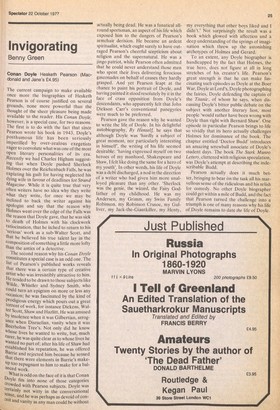Invigorating
Benny Green
Conan Doyle Hesketh Pearson (Macdonald and Jane's £4.95) The current campaign to make available once more the biographies of Hesketh Pearson is of course justified on several grounds, none more powerful than the thought of the sheer pleasure being made available to the reader. His Conan Doyle, however, is a special case, for two reasons. The first is to do with the fact that since Pearson wrote his book in 1943, Doyle's posthumous life has been seriously imperilled by over-zealous exegetists eager to convolute what was one of the most Open literary personalities of its era. ;Recently we had Charles Higham suggest.. log that when Doyle pushed Sherlock Holmes over the Reichenbach Falls, he was expiating his guilt for having neglected his dying wife in favour of deadlines for Strand Magazine, While it is quite true that very often writers have no idea why they write what they write, for once we may be inclined to back the writer against his apologist and say that the reason why Holmes went over the edge of the Falls was the reason that Doyle gave, that he was sick to death of Holmes with his clockwork ratiocination, that he itched to return to his 'serious' work as a sub-Walter Scott, and that he believed his true talent lay in the Composition of something a little more lofty than the antics of a detective.
The second reason why his Conan Doyle constitutes a special case is an odd one. The list of Pearson's published works reveals that there was a certain type of creative artist who was irresistibly attractive to him. He tended to be drawn to those subjects like Wilde, Whistler and Sydney Smith, who could turn an epigram on more or less any occasion; he was fascinated by the kind of Prodigious energy which pours out a great torrent of work, for instance Dickens, Walter Scott, Shaw and Hazlitt. He was amused by insolence when it was Gilbertian, arrogance when Disraelian, vanity when it was Beerbohm Tree's. Not only did he know Whose lives he wanted to write, but, much rarer, he was quite clear as to whose lives he wanted no part of; after his life of Shaw had established his reputation, he was offered Barrie and rejected him because he sensed that there were elements in Barrie's makeup too repugnant to him to make for a balanced work.
What is odd on the face of it is that Conan Doyle fits into none of those categories crowded with Pearson subjects. Doyle was certainly not witty in the conversational sense, and he was perhaps as devoid of conceit and vanity as any man could be without actually being dead. He was a fanatical allround sportsman, an aspect of his life which exposed him to the dangers of Pearson's armchair derision. He became an ardent spiritualist, which ought surely to have outraged Pearson's cheerful scepticism about religion and the supernatural. He was a jingo patriot, while Pearson often admitted that he could never understand those men who spent their lives delivering ferocious gasconades on behalf of causes they hardly grasped. And yet Pearson leapt at the chance to paint his portrait of Doyle, and having painted it stood resolutely by it in the face of crass opposition from Doyle's descendants, who apparently felt that John Dickson Carr's conventional panegyrics were much to be preferred.
Pearson gave the reason why he wanted to write the life of Doyle. In his delightful autobiography, By Himself he says that although Doyle was 'hardly a subject of great moment, nor particularly interesting in himself', the writing of his life seemed desirable: 'having expressed myself on two heroes of my manhood, Shakespeare and Shaw, I felt like doing the same for a hero of my youth:. In other words, his life of Doyle was a debt discharged, a nod in the direction of a writer who had given him more unalloyed pleasure than any other. 'Sherlock was the genie, the wizard, the Fairy Godfather of my childhood. He was my Andersen, my Grimm, my Swiss Family Robinson, my Robinson Crusoe, my Gulliver, my Jack-the-Giantkiller, my Henty, my everything that other boys liked and I didn't.' Not surprisingly the result was a book which glowed with affection and a deep understanding of the springs of imagination which threw up the astonishing archetypes of Holmes and Gerard.
To an extent, any Doyle biographer is handicapped by the fact that Holmes, the true hero, does not figure at all in long stretches of his, creator's life. Pearson's great strength is that he can make fascinating such episodes as Doyle at the Boer War, Doyle at Lord's, Doyle photographing the fairies, Doyle defending the captain of the Titanic, of whom he says, when discussing Doyle's bitter public debate on the subject with another literary lion, most people 'would rather have been wrong with Doyle than right with Bernard Shaw'. One episode in particular Pearson brings to life so vividly that its hero actually challenges Holmes for dominance of the book. The chapter entitled 'Doctor Budd' introduces an amazing screwball associate of Doyle's student days. The book The Stark Munro Letters, cluttered with religious speculation, was Doyle's attempt et describing the indescribable Budd.
Pearson actually does it much better, bringing to bear on the task all his marvellous sense of the ridiculous and his relish for comedy. No other Doyle biographer could get within a mile of Budd, and the fact that Pearson turned the challenge into a triumph is one of many reasons why his life of Doyle remains to date the life of Doyle.


































 Previous page
Previous page